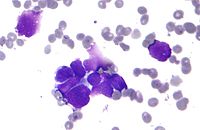
Photo from wikipedia
ObjectiveTo evaluate the effects of Celastrus Orbiculatus extracts (COE) on metastasis in hypoxia-induced hepatocellular carcinoma cells (HepG2) and to explore the underlying molecular mechanisms.MethodsThe effect of COE (160, 200 and… Click to show full abstract
ObjectiveTo evaluate the effects of Celastrus Orbiculatus extracts (COE) on metastasis in hypoxia-induced hepatocellular carcinoma cells (HepG2) and to explore the underlying molecular mechanisms.MethodsThe effect of COE (160, 200 and 240 µ g/mL) on cell viability, scratch-wound, invasion and migration were studied by 3-4,5-dimethyl-2-thiazolyl-2,5-diphenyl-2-H-tetrazolium bromide (MTT), scratch-wound and transwell assays, respectively. CoCl2 was used to establish a hypoxia model in vitro. Effects of COE on the expressions of E-cadherin, vimentin and N-cadherin were investigated with Western blot and immunofluorescence analysis, respectively.ResultsCOE inhibited proliferation and metastasis of hypoxia-induced hepatocellular carcinoma cells in a dose-dependent manner (P<0.01). Furthermore, the expression of epithelial-mesenchymal transition (EMT) related markers were also remarkably suppressed in a dose-dependent manner (P<0.01). In addition, the upstream signaling pathways, including the hypoxia-inducible factor 1 α (Hif-1 α) and Twist1 were suppressed by COE. Additionally, the Hif-1 α inhibitor 3-5′-hydroxymethyl-2′-furyl)-1-benzylindazole (YC-1), potently suppressed cell invasion and migration as well as expression of EMT in hypoxia-induced HepG2 cells. Similarly, the combined treatment with COE and YC-1 showed a synergistic effect (P<0.01) compared with the treatment with COE or YC-1 alone in hypoxia-induced HepG2 cells.ConclusionsCOE significantly inhibited the tumor metastasis and EMT by suppressing Hif-1 α/Twist1 signaling pathway in hypoxia-induced HepG2 cell. Thus, COE might have potential effect to inhibit the progression of HepG2 in the context of tumor hypoxia.
Journal Title: Chinese Journal of Integrative Medicine
Year Published: 2018
Link to full text (if available)
Share on Social Media: Sign Up to like & get
recommendations!